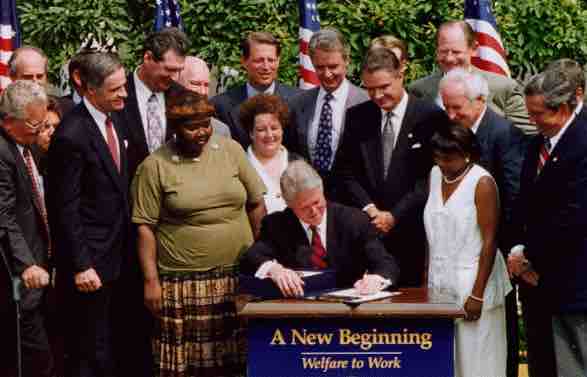Introduction
"Clintonomics" refers to the economic policies of United States President Bill Clinton during the 1990s, as well as the economic policies supported by his staff. According to American political scientist Jack Godwin, Clintonomics was more than a set of economic, fiscal, and monetary policies: it was a governing philosophy with political and economic elements, which routinely appropriated nominally Republican and Democratic ideas. In general, Clinton's approach entailed modernizing the federal government, making it more entrepreneurial, and distributing more authority to state and local governments. This meant making the government smaller, more flexible, less wasteful, and better suited for the global era.

Bill Clinton Signing the Welfare Reform Act of 1996
A central pledge of Clinton's campaign was to reform the welfare system, adding changes such as work requirements for recipients.
Historical Backgrounds
During the 1992 presidential campaign, the United States had undergone 12 years of conservative policies implemented by Ronald Reagan and George H. W. Bush. Clinton ran on the economic platform of balancing the budget, lowering inflation, lowering unemployment, and continuing the traditionally conservative policies of free trade. In 1992, Bill Clinton was elected President of the United States, and during his presidency (1993 to 2001), he implemented several economic reforms.
The Policies of Clintonomics
Federal Appointments
Economist Alan Greenspan served as the Chair of the Federal Reserve's board of governors throughout Clinton's presidency. Clinton also appointed two widely considered "moderate advocates of tight money", Alice Rivlin and Laurence Meyer, and other appointments to the central bank perpetuated this trend of moderates. The effects of appointing tight money proponents to the Federal Reserve showed up in the Consumer Price Index (CPI), which stabilized during the 1990s at a fairly low rate, never rising above 5% during the Clinton presidency.

Alan Greenspan
Alan Greenspan was the Chairman of the Federal Reserve throughout the Clinton presidency. Of all the presidents with whom he worked, he praised Bill Clinton above all others, saying that Clinton maintained "a consistent, disciplined focus on long-term economic growth."
Regulatory Policy
The only laws of the Clinton administration that could be considered deregulatory were the Telecom Reform Act of February 8, 1996, which eliminated ownership restrictions on radio and television; the pesticides legislation of 1996; and the Food and Drug Administration overhaul of 1997. All were signed into law by Clinton, along with the Financial Services Modernization Act of 1999, which allowed banks, insurance companies and investment houses to merge, thus repealing the Glass-Steagall Act, which had been in place since 1932. Some point to this as a partial cause of the financial meltdown of 2008.
Fiscal Policy
Clinton signed the Omnibus Budget Reconciliation Act of 1993 into law. This Act cut taxes for 15 million low-income families, made tax cuts available to 90% of small businesses, and raised taxes on the wealthiest 1.2% of taxpayers. Additionally, through the implementation of spending restraints, it mandated the budget be balanced over a number of years. The cap was repealed on Medicare, taxes were raised 4.3 cents per gallon on transportation fuels, and the taxable portion of Social Security benefits was increased. The Personal Responsibility and Work Opportunity Act of 1996 represented a fundamental shift in both methods and goal of the federal cash assistance to the poor; the law fulfilled Clinton's 1992 campaign promise to "end welfare as we have come to know it."
NAFTA
Clinton also strongly supported ratification of the North American Free Trade Agreement (NAFTA), a treaty that eliminated tariffs and trade restrictions among the United States, Canada, and Mexico. The treaty had been negotiated by the Bush administration, and the leaders of all three nations had signed it in December 1992. However, because of strong opposition from American labor unions and some in Congress who feared the loss of jobs to Mexico, the treaty had not been ratified by the time Clinton took office. To allay the concerns of unions, Clinton added an agreement to protect workers as well as an agreement to protect the environment. Congress ratified NAFTA late in 1993, and the result was the creation of the world’s largest common market in terms of population, including some 425 million people.
Macroeconomic Policies
Clinton's macroeconomic policies can best be examined through three main categories: gross domestic product (GDP), inflation rates, and unemployment rates. Among many parts of Clinton's policy to lower the deficit, he allowed for the passing of laws that raised the money in the U.S. Treasury. During his administration, the nation began to experience the longest period of economic expansion in its history, almost ten consecutive years. Year after year, job growth increased and the deficit shrank. Increased tax revenue and budget cuts turned the annual national budget deficit from close to $290 billion in 1992 to a record budget surplus of over $230 billion in 2000. Reduced government borrowing freed up capital for private-sector use, and lower interest rates in turn fueled more growth. During the Clinton years, more people owned homes than ever before in the country’s history (67.7 percent). Inflation dipped to 2.3 percent and the unemployment rate declined, reaching a thirty-year low of 3.9 percent in 2000.